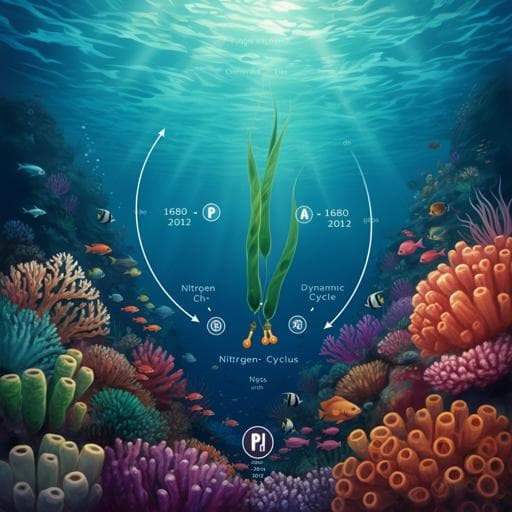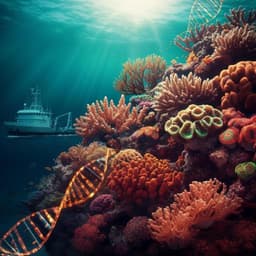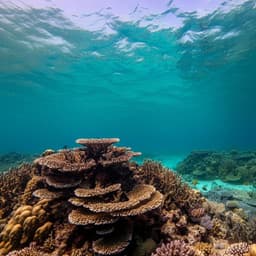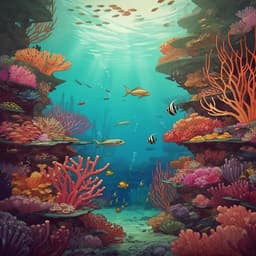
Environmental Studies and Forestry
Coral skeletons reveal the history of nitrogen cycling in the coastal Great Barrier Reef
D. V. Erler, H. T. Farid, et al.
Explore the intriguing dynamics of nitrogen cycling in the Great Barrier Reef! This research, conducted by Dirk V. Erler, Hanieh Tohidi Farid, Thomas D. Glaze, Natasha L. Carlson-Perret, and Janice M. Lough, reveals a surprising long-term decline in nitrogen ratios, suggesting a shift towards increased coastal nitrogen fixation amidst rising anthropogenic inputs. Discover how reducing phosphorus discharge could be key to preventing future ecological crises.
~3 min • Beginner • English
Introduction
The study investigates how nitrogen (N) cycling in the coastal Great Barrier Reef has responded to increased terrestrial nutrient inputs since European settlement in the 1850s. While many coastal systems exhibit eutrophication with increased nutrient inputs, the GBR shows mixed signals: rising modeled and proxy-derived nutrient loads, yet persistent low inorganic N concentrations and regional budgets indicating strong N deficits and relative phosphorus (P) surplus. Enhanced denitrification in sediments likely promotes N loss and P accumulation, leading to N limitation that can stimulate N2 fixation. The key research questions are whether coastal N2 fixation has increased in response to anthropogenic nutrient enrichment and how long-term N source and availability have changed. The authors use the nitrogen isotopic composition (δ15N) of coral skeleton-bound organic matter (CS-δ15N) as a proxy for the integrated δ15N of marine N available to corals, to reconstruct multi-century changes in N sources and cycling and to test whether anthropogenic N inputs or stimulated N2 fixation best explain observed trends.
Literature Review
Prior work shows increasing particulate and dissolved nutrient inputs to the GBR since European settlement (e.g., river load modeling and coral proxy records). Some argue parts of the coastal GBR are eutrophic, but nutrient budgets indicate N deficits and surplus P, implying N limitation and conditions favorable for N2 fixation. Observations show low inorganic N concentrations outside major flood events and efficient sedimentary denitrification. Earlier studies proposed increased N2 fixation linked to anthropogenic change, but lacked long-term records to substantiate trends. Coral skeleton-bound δ15N has been established as a proxy for marine N sources and availability, integrating signals from terrestrial inputs, microbial processing, and N2 fixation. Literature also indicates that agricultural practices can raise δ15N of terrestrial N delivered to coasts due to biogeochemical processing, complicating direct attribution of coral δ15N changes to fertilizer inputs alone.
Methodology
Study area and sampling: Four Porites lutea coral cores (two from Havannah Island and two from Pandora Reef) in the central inshore GBR were analyzed (2–3 samples per year). An additional short core from Geoffrey Bay (Magnetic Island) extended a previously published record. Sites lie between the Burdekin and Herbert Rivers and are relatively unaffected by Coral Sea upwelling.
Coral preparation and CS-δ15N analysis: Ultrasonically cleaned skeletal slabs were micromilled along the central growth axis. Approximately 100 mg carbonate powders were collected from high and low density bands (minimum two, up to three samples per year depending on extension), ground to <63 µm, and chemically cleaned with ultrapure NaClO bleach. Intra-crystalline organic N was liberated and oxidized with persulfate to nitrate, converted to N2O, and δ15N of N2O measured using a Thermo Delta V Plus IRMS via a GasBench II with custom purge-and-trap. Analyses were in triplicate with analytical precision of 0.4‰. Chronologies were based on existing banding/luminescence records.
Water sampling and isotopic constraints: Coastal water samples were collected before (Nov 2018, Sites 4–6) and after (Mar 2019, Sites 1–6) a major Burdekin flood plume using Niskin bottles at 1 and 5 m. Total dissolved nitrogen (TDN) concentrations (flow injection analysis) and δ15N of TDN were measured; particulate N (PN) δ15N and N content were determined with an elemental analyzer-IRMS. δ15N-TDN values in the plume were used with an isotope mixing model to estimate the terrestrial endmember δ15N-TDN.
Hydroclimate proxy and correlations: Reconstructed Burdekin River flow anomalies (annual water year, 1680–2011) from coral luminescence were used to assess relationships between river flow and CS-δ15N via moving 30-year window correlations. High- and low-pass filtering of CS-δ15N series was applied for visualization of variability at different timescales.
Statistical analyses: Trends in composite site records (0.5-year binned) were assessed using the Mann–Kendall trend test. Comparisons of mean CS-δ15N across time periods used Student’s t-tests. Change point analysis (minimum improvement threshold 0.4) identified abrupt shifts, with values normalized to long-term means. Additional isotope mixing modeling (described in Supplementary Text) was used to estimate the contribution of N2 fixation to the coastal N pool.
Quality/replication: Two cores per site created composite records for Pandora and Havannah; Magnetic Island composite included a long and a new short core extension. Triplicate analyses ensured analytical precision.
Key Findings
- CS-δ15N records from Havannah Island and Pandora Reef are significantly and positively correlated over their 143-year overlap (1863–2005; r = 0.56, p < 0.001) with similar long-term means (Havannah 6.0 ± 0.7‰; Pandora 5.8 ± 0.6‰), indicating ecosystem-level signals rather than individual coral physiology.
- Both sites show significant long-term decreases in CS-δ15N towards the present: Havannah Island exhibits a significant negative trend (Mann–Kendall p < 0.001) from 1680–2012; Pandora Reef shows a significant negative trend from 1863–2012 (Mann–Kendall p < 0.001).
- At Havannah Island, the first 100 years (1680–1780) had mean CS-δ15N of 6.4 ± 0.5‰, significantly higher than the last 100 years (mean 5.8 ± 0.4‰; Student’s t-test p < 0.001). The 1940–2012 mean decreased further to 5.6 ± 0.4‰ (≈0.8‰ lower than 1680–1780).
- Magnetic Island’s updated composite record shows a significant CS-δ15N decline between 1860 and 2011 (slope ≈ −0.002‰ yr−1), reconciling earlier stability by extending the series and accounting for historical dredge spoil impacts and differing runoff influence.
- Relationship with river flow changed over time: CS-δ15N was positively correlated with Burdekin River flow anomalies pre-1940 (and during similar-flow periods pre-1770) but became weak or inverse after ~1940, with more frequent minima and reduced positive change point magnitudes, indicating lower CS-δ15N at comparable runoff levels post-1940.
- δ15N-TDN measurements: During the March 2019 Burdekin flood plume, δ15N-TDN ranged from 6.2 ± 0.1‰ at the river mouth to 4.6 ± 0.6‰ offshore; pre-flood (Nov 2018) Sites 4–6 averaged 4.1 ± 0.7‰. An isotope mixing model estimated the terrestrial endmember δ15N-TDN at 8.1 ± 1.1‰, higher than catchment soil and fertilizer δ15N.
- Given that coral CS-δ15N typically exceeds source δ15N by up to ~2‰, the high terrestrial δ15N-TDN is inconsistent with the observed decline in CS-δ15N. Together with literature showing elevated δ15N in terrestrially derived material during runoff, results indicate that enhanced N2 fixation (low δ15N source) rather than fertilizer-driven terrestrial N dominance explains the declining CS-δ15N.
- Overall, records indicate increased coastal N2 fixation in the GBR since European settlement, particularly evident after ~1940, likely driven by N limitation arising from preferential N losses (denitrification) and relative P enrichment.
Discussion
The multi-century coral CS-δ15N records resolve how the coastal GBR’s N cycle has responded to anthropogenic nutrient inputs. Despite rising terrestrial nutrient loads, the sustained decline in CS-δ15N and the altered relationship with river flow after ~1940 indicate that a low-δ15N N source—coastal N2 fixation—has increasingly contributed to the N available to corals. This aligns with nutrient budgets and observations of N limitation and P surplus: enhanced denitrification preferentially removes reactive N while P accumulates, depressing N:P ratios and favoring diazotrophs. The water-column δ15N-TDN endmember (~8‰) suggests that terrestrially delivered N is too 15N-enriched to account for declining CS-δ15N, reinforcing the interpretation that N2 fixation increased. These findings address the research question by showing that the GBR’s coastal N cycle exhibits a feedback to anthropogenic nutrient enrichment: N losses and P accumulation stimulate N2 fixation, partially compensating N deficits while keeping inorganic N concentrations low outside flood events. Management implications include focusing on reducing P inputs to disrupt this feedback and mitigate risks of eutrophication and harmful algal proliferation.
Conclusion
Using coral skeleton-bound nitrogen isotopes from multiple inshore GBR reefs, the study provides a 333-year record showing a robust, long-term decline in CS-δ15N toward the present and a post-1940 shift in the linkage with river flow. Coupled with water-column isotopic constraints, the results indicate that increased coastal N2 fixation—rather than direct dominance of terrestrial fertilizer-derived N—has shaped modern N cycling in the coastal GBR in response to anthropogenic pressures. This proxy-based reconstruction highlights an ecosystem feedback where denitrification-driven N deficits and P accumulation promote diazotrophy. Management actions that reduce phosphorus discharge are likely to weaken this feedback and lower eutrophication risk. Future work should expand spatial coverage across GBR regions with varying riverine influence, integrate direct measurements of N2 fixation and denitrification with proxy records, and refine isotopic endmember characterizations through targeted event-based and seasonal sampling.
Limitations
- Geographic scope is limited to a central inshore GBR region between the Burdekin and Herbert Rivers; results may not capture variability across the broader GBR, including areas influenced by upwelling or different catchments.
- The study infers processes from proxy records; direct long-term measurements of N2 fixation and denitrification rates are lacking.
- Terrestrial δ15N estimates rely on limited contemporary sampling and mixing model assumptions; endmember characterization is uncertain and temporally sparse relative to the coral record.
- Historical local disturbances (e.g., dredge spoil near Magnetic Island) could affect CS-δ15N signals and complicate site comparisons.
- Filtering and correlation analyses depend on reconstruction quality of river flow proxies and may be sensitive to chronological uncertainties and non-stationarity.
Related Publications
Explore these studies to deepen your understanding of the subject.







